Key takeaways:
- Hospital ministry provides vital spiritual support, fostering resilience and connection among patients, families, and healthcare staff.
- Hope significantly enhances the healing process, serving as both a personal motivator and a collective force within the hospital community.
- Active listening, positive affirmations, and creative expression are effective strategies to nurture hope in patients.
- Building genuine relationships with patients through personal stories and small acts of kindness creates a supportive environment that promotes healing.
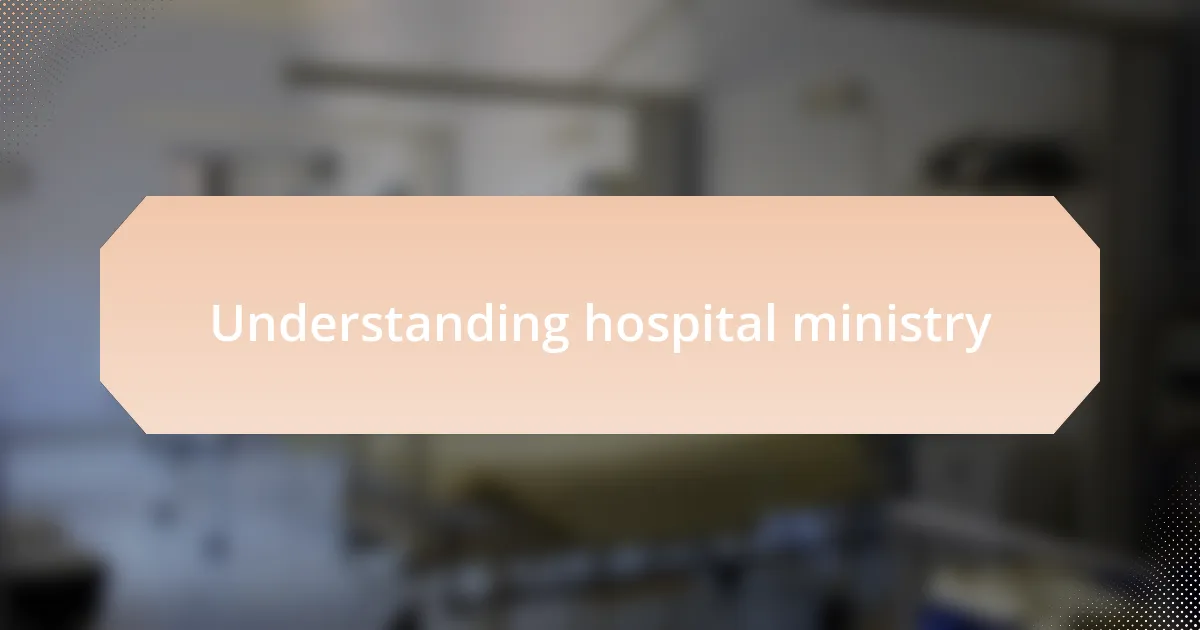
Understanding hospital ministry
Hospital ministry is a compassionate outreach that provides spiritual support to patients, families, and healthcare staff within a hospital setting. I remember a time when I sat with a distraught family in a waiting room, their faces etched with anxiety. In that moment, I realized how crucial it is to offer not just prayers, but a listening ear and a warm presence to foster hope amidst uncertainty.
Engaging with patients can often reveal profound insights about resilience and faith. One particular patient shared how her battle with illness deepened her understanding of grace. It made me reflect: how often do we overlook the transformative power of vulnerability? Each conversation uncovers a new layer of the human experience, strengthening the bonds of community in a place often filled with fear.
Moreover, hospital ministry is not just about offering spiritual care to others; it is also a journey of personal growth for those involved. I sometimes wonder how many caregivers leave the hospital each day carrying stories of hope and healing. This dynamic exchange of love and faith reinforces the idea that even in our darkest moments, there is potential for light and connection through shared experiences.

Importance of hope in healing
Hope plays a pivotal role in the healing journey. I recall visiting a young patient who was startled by the daunting walls of the hospital. During our chat, I asked her what kept her spirits up. Her response—”Hope is my secret weapon”—resonated deeply with me. It struck me that hope fuels not only physical recovery but also mental resilience, propelling individuals to face their battles with renewed strength.
In my experience, hope acts as a bridge during difficult times. I remember an elderly man who, despite his ongoing treatments, spoke of the future with such optimism. When he shared his dreams of attending his granddaughter’s wedding, I couldn’t help but wonder: how can we harness such hope to create a supportive environment? This sense of purpose can elevate the spirit and make each day a little brighter, underscoring the profound connection between hope and healing.
Moreover, I’ve seen how hope can become a collective force within the hospital community. While sitting in a group session, I noticed how the shared stories among patients sparked an infectious sense of optimism. It made me reflect on the question: what if we all embraced hope as a shared responsibility? Together, we can cultivate an atmosphere where healing thrives, reminding one another that we are not alone, but part of a larger tapestry of care and love.
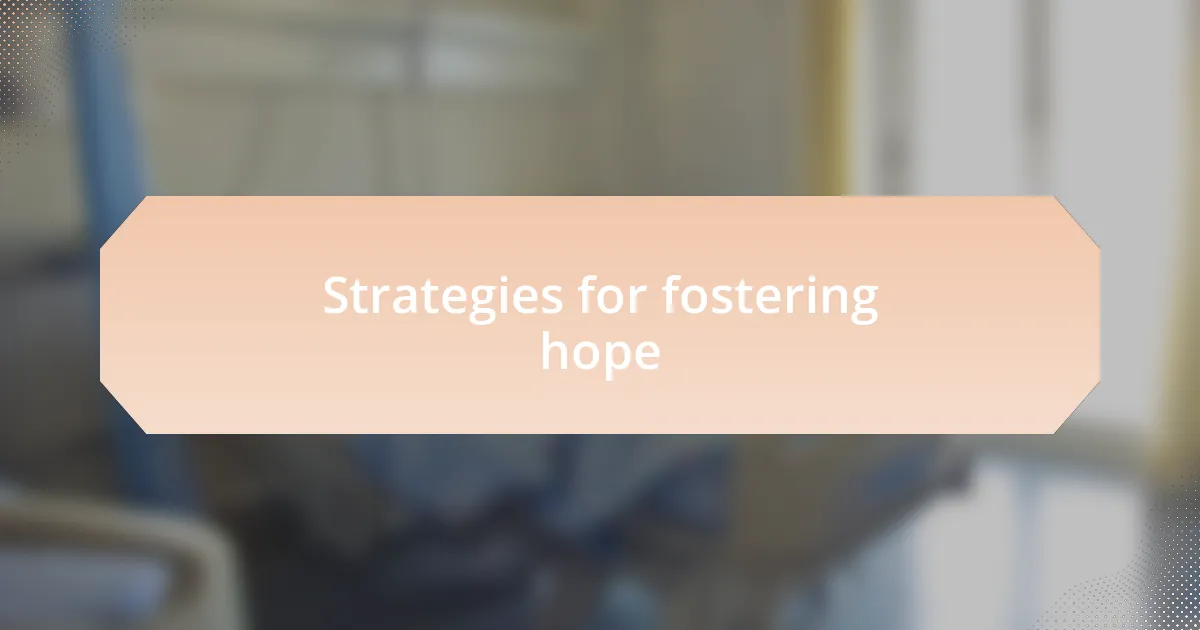
Strategies for fostering hope
One effective strategy for fostering hope is through active listening. I remember sitting with a patient who felt overwhelmed by their diagnosis. Instead of jumping in with advice, I simply listened to their fears and aspirations. This moment of connection allowed them to voice their concerns, transforming despair into a shared understanding. Isn’t it remarkable how simply being heard can spark a glimmer of hope?
Encouraging positive affirmations is another powerful approach. In one of my interactions, I guided a patient to write down three things they were grateful for each day. At first, it felt challenging, but as the days passed, they began to recognize the small joys amidst their struggles. This practice not only illuminated sources of hope but also fostered a sense of agency in their healing journey. Have you ever found that shifting focus can reveal new paths forward?
Lastly, creating rituals can anchor hope in daily life. I once collaborated with a team to introduce a weekly “Hope Circle” where patients and staff alike shared their victories, big or small. It was incredible to witness how this simple gathering blossomed into a celebration of resilience. I often ponder: how might we all benefit from carving out moments dedicated to reflecting on our collective strength? These strategies, while simple, can fundamentally reshape the way we approach difficult times, nurturing hope and healing together.
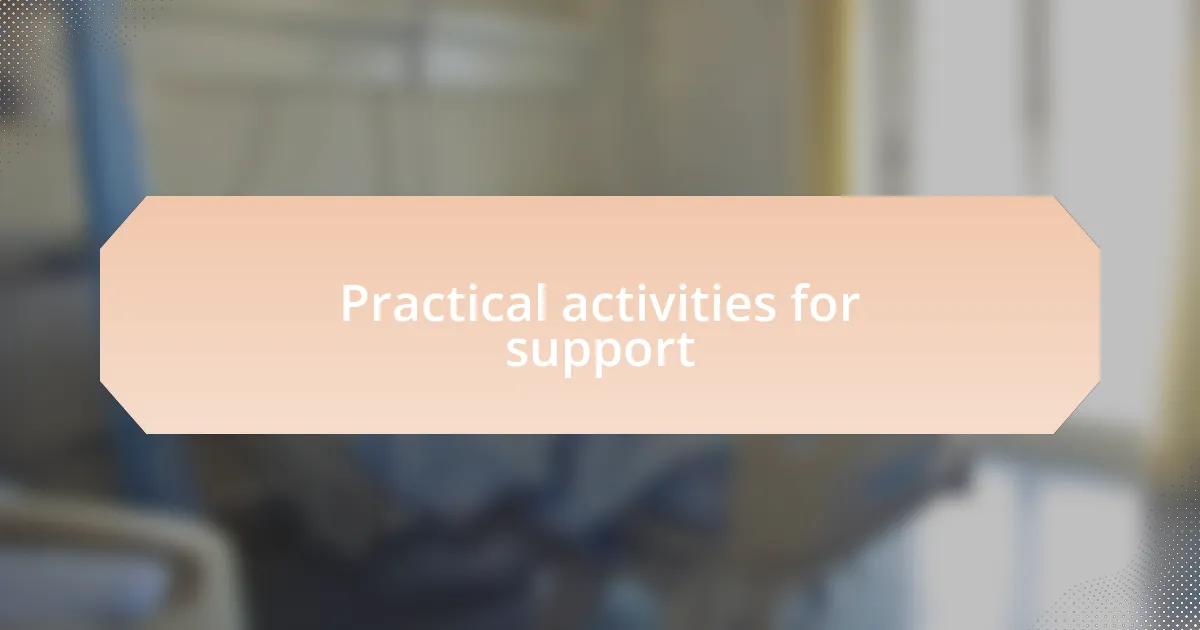
Practical activities for support
One practical activity that I’ve found incredibly effective is organizing support groups where patients can share their experiences. I vividly recall a session where individuals, initially strangers, quickly transformed into a supportive community. By voicing their stories, they not only felt less isolated but also found common ground that fostered a sense of hope. Isn’t it uplifting to witness people uplift each other through shared vulnerability?
Another impactful approach is initiating creative expression workshops, such as art therapy. I once facilitated a painting session, and seeing participants channel their feelings onto canvas was truly inspiring. It wasn’t just about creating art but about expressing emotions in a safe space. How often do we underestimate the healing power of creativity in our lives?
Lastly, I advocate for regular wellness check-ins with patients and families. I remember reaching out to a family who had been through a tough time. Just a simple phone call to ask how they were managing made all the difference. It reminded them that they weren’t alone in their journey. Could there be anything more encouraging than knowing someone cares enough to ask?
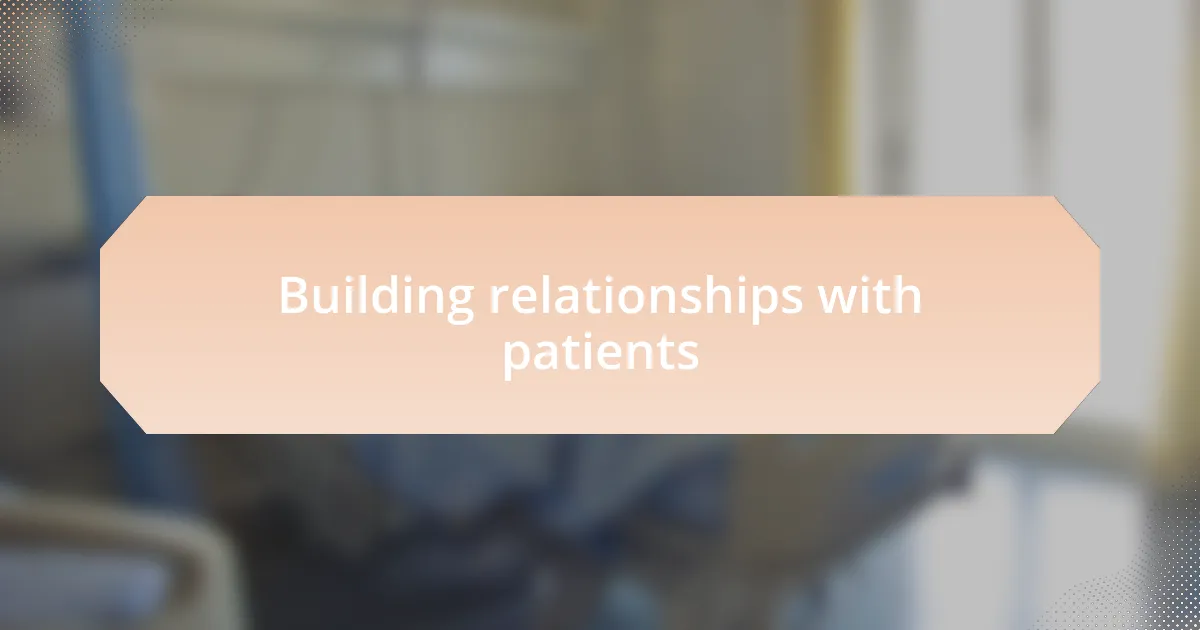
Building relationships with patients
Building relationships with patients is all about genuine connection. I remember visiting a patient who had been in and out of the hospital for months. Instead of just completing my rounds, I took the time to sit with her and ask about her life before her illness. The conversation flowed easily, and by the end, she was smiling and sharing her favorite memories. Isn’t it amazing how a small act of listening can lighten someone’s burden?
Understanding that every patient has a unique story is crucial. One time, I worked with a gentleman who was hesitant to talk and kept to himself. I decided to bring in a familiar magazine from his favorite hobby—fishing. When he saw it, a spark ignited, and before I knew it, we were deep in discussion about his biggest catches. It’s a powerful reminder that sometimes, all it takes is to meet them where they are to build trust.
I also find value in follow-ups. Recently, I sent a heartfelt message to a patient who had overcome significant hurdles during her treatment. She later told me that my message made her day and reminded her that her journey mattered. How often do we reflect on the impact of simple gestures like this? The connections we build truly can become a source of strength for both patients and caregivers alike.
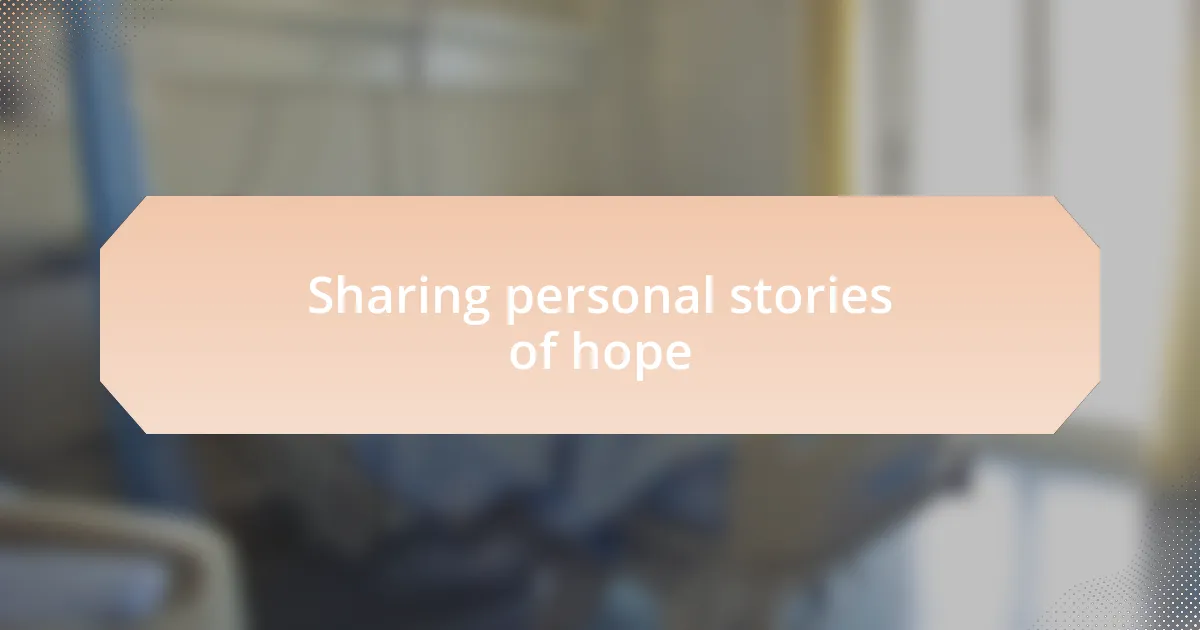
Sharing personal stories of hope
Sharing personal stories of hope can illuminate the darkest moments for patients and their families. I recall a young mother who faced a grueling diagnosis. One day, as we talked, she shared her dream of celebrating her daughter’s birthday, even in the midst of treatment. Hearing her vision inspired me to create a small celebration right there in the hospital room, complete with decorations and a cake. The joy on her face that day wasn’t just a fleeting moment; it was a powerful reminder of the hope that can thrive even in challenging circumstances.
I’ve also witnessed the profound impact of stories passed on through generations. An elderly man I knew often spoke about his late wife’s unwavering spirit during her illness. One afternoon, as he recounted how she created a garden filled with bright flowers to lift their spirits, I realized that these stories serve as beacons of hope. They show patients that resilience is possible and that love can endure even in hardship. Isn’t it wonderful how sharing these tales can nurture strength?
There was a time when I facilitated a group sharing session in the hospital’s community room. Patients gathered to share their experiences and, unexpectedly, witnessed a transformation. As they opened up about their struggles and triumphs, the atmosphere shifted—from one of fear to one of camaraderie and support. What struck me was how their collective hope became palpable. In that space, they learned that sharing their stories not only nurtured their own spirits but also sparked hope in others. Isn’t it remarkable how vulnerable moments can create a tapestry of strength among individuals facing life’s toughest challenges?
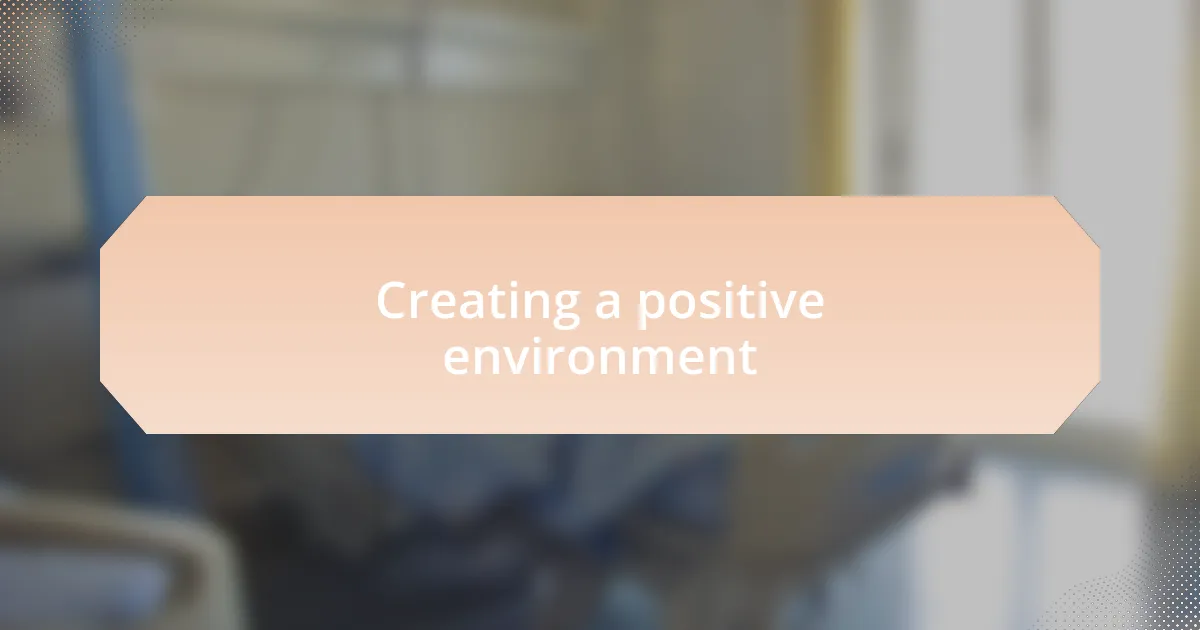
Creating a positive environment
Creating a positive environment within a hospital setting is essential for nurturing hope and healing. I remember one particular day when I arrived at the ward to find the usual somber atmosphere permeated by uplifting music. A fellow volunteer had organized a mini concert, and the cheerful melodies transformed not just the physical space but also the emotional landscape. It made me think: how often do we overlook the simple power of music to elevate our spirits during tough times?
One thing I’ve learned in my ministry is that small gestures can make a significant difference. On a particularly challenging day with a patient undergoing a difficult procedure, I brought in colorful drawings made by local children. Watching the patient’s face light up as they explored each piece was a revelation for me. It dawned on me that creating a vibrant and hopeful environment doesn’t require grand gestures; sometimes, it’s the little things—a drawing, a song, or even a warm smile—that can resonate deeply with those in distress.
There’s something about a warm cup of tea shared in a quiet corner of the hospital that fosters connection. I recall sitting with an anxious patient, simply talking and sipping tea as we discussed their favorite hobbies. In that moment, the clinical space transformed into a sanctuary of comfort. It’s interactions like these that remind me how important it is to cultivate a space where patients feel valued and heard. Have you ever noticed how the smallest acts of kindness can ignite hope in the most challenging circumstances?